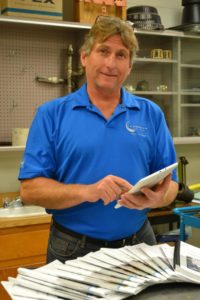Camosun College recently placed second in BCcampus’ annual review of the Open Textbook Project. Camosun Plumbing and Pipe Trades instructor Rod Lidstone spearheaded the project at the college; he says students will continue to save money with open resources—such as free, online textbooks—in years to come.
“I’m curious where we will come out this year. We may, in fact, be on top,” he says. “We’ve got over 50 adoptions [a course or program recognizing open textbooks], and it’s impacted over 950 students at Camosun.”
Lidstone says the top three colleges that are utilizing open textbooks—Kwantlen Polytechnic University, Camosun, and Okanagan College—are smaller academic institutions, compared to bigger universities. Lidstone says smaller institutions can sometimes be more willing to face change.

“At Camosun, I think one of the reasons we’re so high is that [due to] the size of our institution, the instructors really have a good feel for the feedback from the students and seem to connect with the students quite closely, being a smaller college. Sometimes the bigger institutions seem to get more committed to the publishers and not wanting to change the way of doing business.”
Lidstone doesn’t know the exact reason many of the bigger institutions are not as high up on the list, but he says there is a correlation between institution size and willingness to try new things that help students.
“It seems to be that there’s something going on there,” he says. “The ones that are the highest users of open resources are not the biggest institutions.”
BCcampus senior manager of open education Amanda Coolidge says that the choice of materials used depends on communication between faculty and BCcampus.
“The way it works is we track adoption numbers, so we identify which books have been adopted by various faculty,” she says. “And so when the faculty let us know they’ve adopted a book, we then track how much the commercial textbook costs and how many students were in the classroom and then identify what the cost savings is for that particular course in that particular term.”
Coolidge says that Lidstone has been instrumental in the process of adoption at the college.
“We’ve been really pleased to see the work done by faculty and staff at Camosun and their dedication to the open movement,” she says. “Rod Lidstone has been a real advocate and champion for open education.”
Lidstone says that it’s a great feeling to help students because many of them struggle with the costs of higher education.
“I think it will continue to grow,” says Lidstone. “The trades side of the open textbooks is in its infancy, and many more of the trades in Camosun, as well as across the province, are adopting the open resources.”
Lidstone says that in years to come, students will begin to expect that textbooks will be accessible for free.
“All the students in this day and age are aware of open resources,” he says. “They all use Wikipedia. They’re becoming more and more educated to those open resources that are available, and as they become aware of those, they’ll start to see that the quality of those resources gets better and better. There will be an expectation that their faculty should be using these resources and saving them money.”
Getting the Open Textbook Project to this point at the college has not been easy for Lidstone, who admits that there have been some troubles.
“The biggest challenge is someone will be committed to an existing textbook that may come pre-packaged from publishers with PowerPoints, lesson plans, and quizzes, and so the path of least resistance is for that faculty to continue to use that textbook,” he says.
Lidstone says that with the Trades Access Common Core classes, for example, there are various electronic elements—such as animation—to go along with the online text.
“It will become more of a package besides just the textbooks,” he says, “and that’s what faculty needs to see before they’re willing to make change.”
